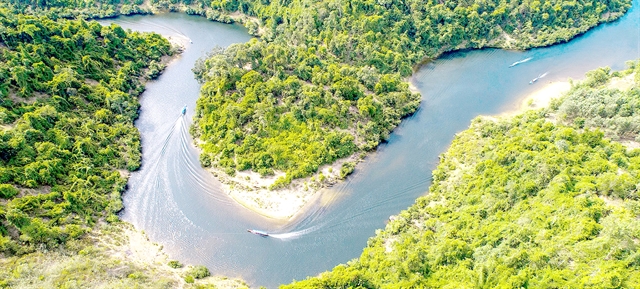 Environment
Environment

 |
| The upstream of Giang River in Nghệ An Province's western district Con Cuông, part of the Western Nghệ An Biosphere Reserve. — Photo Lê Quang Dũng |
NGHỆ AN — The People's Committee of central province Nghệ An has unveiled a comprehensive plan to manage and protect the environment of the Western Nghệ An Biosphere Reserve until 2027, with a vision to 2030.
The plan aims to address environmental degradation of the natural heritage site, conserve biodiversity; support research, monitoring, training and community education on conservation practices and sustainable development, contributing to socio-economic development and climate change adaptation.
Nghệ An set a goal of developing ecological economic models through socio-economic development activities, efficient exploitation and sustainable management of forest natural resources and unique cultural values of the community. It will leverage multi-functional values of forest ecosystem, payment for forest environmental services, carbon credit trading, ecotourism development, landscape preservation closely linked with biodiversity conservation and climate change adaptation, towards improving people’s income in the western Nghệ An region.
The province's People's Committee requests that the environmental management and protection objectives of the Western Nghệ An Biosphere Reserve be integrated into the planning, plans, and development programmes of all levels, sectors, units, and localities etc. to ensure the conservation of nature, environmental protection, and sustainable development of the reserve. Therefore, this plan will encourage the participation of the entire society and mobilise resources from various programmes.
Periodic assessments will be conducted every five years (starting 2023-2027) on the environmental changes and the natural values that need protection and conservation according to the seven criteria for recognition of UNESCO’s Biosphere Reserve.
The province also decides to establish Pù Xai Lai Leng Nature Reserve within the reserve, and seeks to transform areas with high level of biodiversity from Tam Hợp Commune (Tương Dương District) to Nậm Càn and Na Ngoi Communes (Kỳ Sơn District) into special-use forests, connecting with Pù Mát National Park and Bolikhamsai Ecological Restoration Area of Laos.
The province also wants to establish a 'comprehensive biological corridor' connecting the Pù Mát National Park-Pù Xai Lai Leng Peak-Pù Hoạt Nature Reserve corridor with interregional and cross-border corridors bordering Laos.
The Western Nghệ An Biosphere Reserve was officially recognised by UNESCO as a World Biosphere Reserve on September 18, 2007, with a total area of 1,299,795ha, the largest in Southeast Asia. It serves as a green corridor connecting three core zones, including Pù Mát National Park, Pù Huống Nature Reserve and Pu Hoạt Nature Reserve.
This area boasts a high level of biodiversity with a rich variety of species, ecosystems and gene sources of plants. It has recorded 3,627 plant species belonging to 1,184 genera, 205 families, and 39 orders, along with 480 genera and 942 vertebrate species and over 1,000 insect species. It is home to many endangered and rare plant species, including 134 species listed in the 2007 Vietnam Red Data Book, 20 species listed in the International Union for Conservation of Nature (IUCN) Red List of Threatened and Endangered Species 2021, and a wealth of valuable medicinal plants.
This is also the ‘common house’ of six ethnic groups who have lived for generations and still preserve unique traditional cultural values and important historical-cultural relics associated with their development process. — VNS